Wondering what colors make red? When it comes to mixing pigments, there is an endless debate between the world of art and science. This process is known as subtractive mixing.
As you probably learned in art class, no combination of two colors makes red because red is a primary color. But this is not true if we look at the subtractive CMY color model.
However, when we talk about color mixing, we have to consider the effects of light. So, we can’t discuss subtractive mixing without considering the importance of additive color.
Don’t worry. If you don’t know what it means, you’ll find out below!
How We Perceive Color
When the human eye perceives color, magical things happen. What’s more, light plays a vital role in mixing colors.
Specifically, human vision or a healthy eye has three types of receptors in the retina. These are called cone cells, allowing us to see over 100 shades per receptor. [1]
Each cone cell type is sensitive to photons of a specific wavelength. They are nicknamed L, M, and S for long, medium, and short wavelengths.
While long wavelengths are perceived by these cells as red, short wavelengths are blue. The medium ones appear green.
So all the colors we perceive are actually mixtures of multiple wavelengths.
In today’s article, we will discuss the colors that make red when mixed and how you can create different tints and shades of red by mixing two or more colors.
Introduction to Color Types
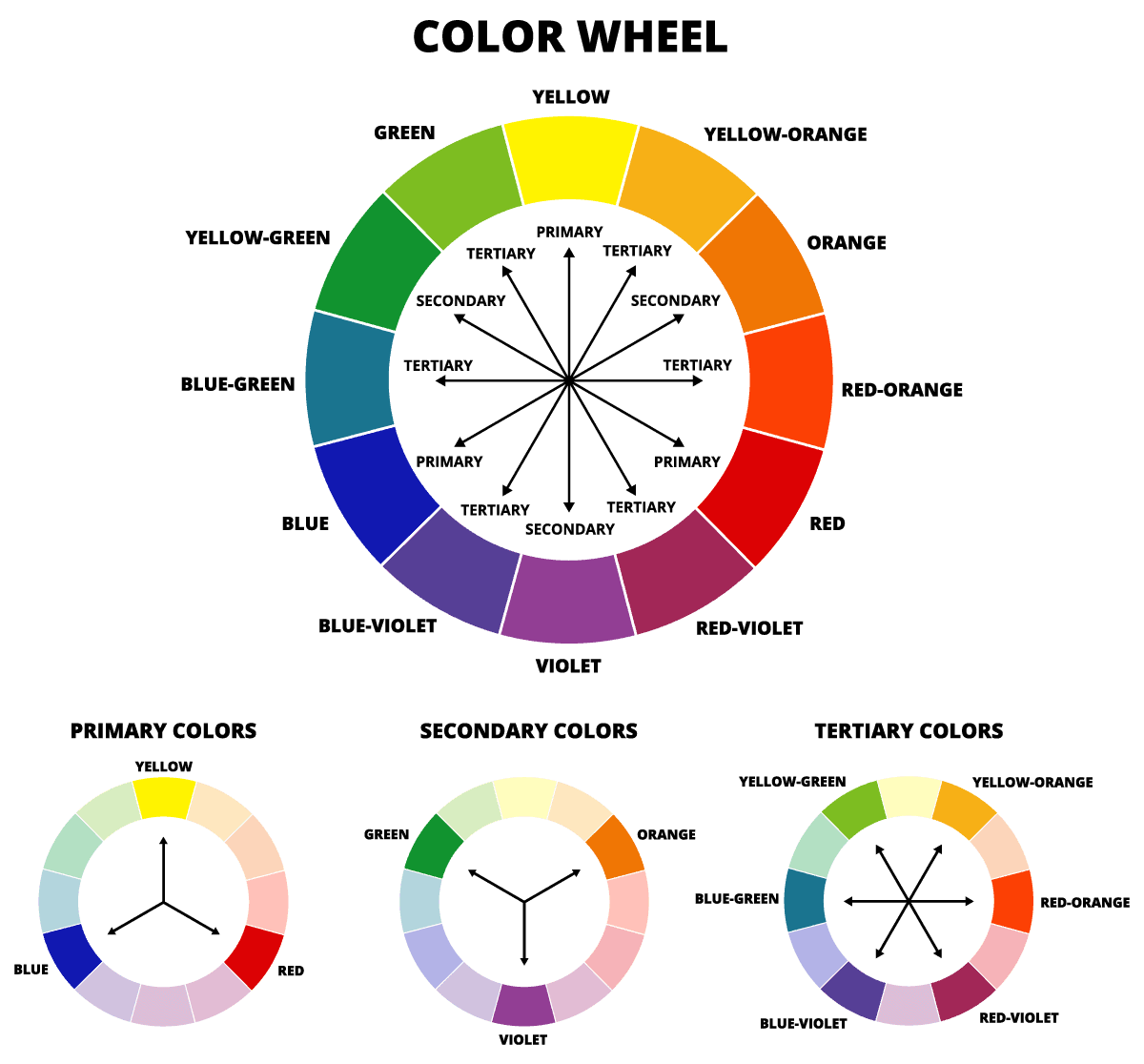
Before learning more about how you get red, we need to cover some information about color theory.
When it comes to mixing paints, we use subtractive color mixing. One of the subtractive color models is RYB, which is used in traditional art.
As with any color model, colors are divided into three broad categories:
- Primary colors
- Secondary colors
- Tertiary colors
While tertiary colors are also referred to as intermediate colors in the world of physics (RGB color model), they differ in traditional art’s RYB color space. More precisely, they are created differently.
Primary Colors
When dealing with paints, as you may recall from school, there are three primary colors: red, blue, and yellow. These are the foundation of color theories and describe how artists mix paint pigments to make colors.
The process of producing the paint colors is called subtractive color mixing. It’s called ‘subtractive’ because you mix pigments that subtract certain wavelengths of light and reflect others.
The primary colors cannot be produced by mixing other secondary or tertiary colors.
If you mix the three primary colors, they cancel each other out, and you get a muddy brown.
If you look at the RYB color wheel, you will see that mixing the three produces black, but this is a common misconception as the paint pigments are not pure and lean towards other hues such as green, orange, or purple. Almost every primary color carries a color bias.
However, you can mix other tints and shades to produce variations of a primary color.
Secondary Colors
Secondary colors in traditional art are orange, green, and purple. These are produced by mixing pairs of primary colors.
Red + Blue = Violet
Red + Yellow = Orange
Blue + Yellow = Green
As you can see, the primary and secondary colors cover six of the seven colors of the rainbow.
Tertiary Colors
Tertiary colors are created by mixing a primary with a secondary color. These include red-violet, blue-green, yellow-green, yellow-orange, red-orange, and blue-violet.
Another definition of tertiary colors is provided by color theorists such as Josef Albers and Moses Harris.
They suggest that tertiary colors are created by mixing pairs of secondary colors, while the colors resulting from mixing primaries and secondaries are called intermediate colors.
In this case, the tertiary colors would be slate, olive, and brown.
Green + Violet = Slate
Green + Orange = Olive
Violet + Orange = Brown
Neutral Colors
In art, there are two colors that are considered neutral. These are black and white, which, when mixed, produce different shades of gray. Thus, gray is also a neutral color.
Black and white are not recognized as colors. They are called neutral colors because they don’t have hue undertones.
While some call them shades because they augment colors, others call them achromatic colors because they lack a dominant hue.
However, achromatic hues are qualities or attributes that include black, white, gray, and starlight. [2]
Furthermore, scientists do not call them colors because neither has its own wavelength on the visible spectrum.
Since their mixing produces different shades of gray, they can be considered neutral colors. Furthermore, they can be called achromatic colors because they contain all light wavelengths without a dominant hue.
What Colors Make Red?
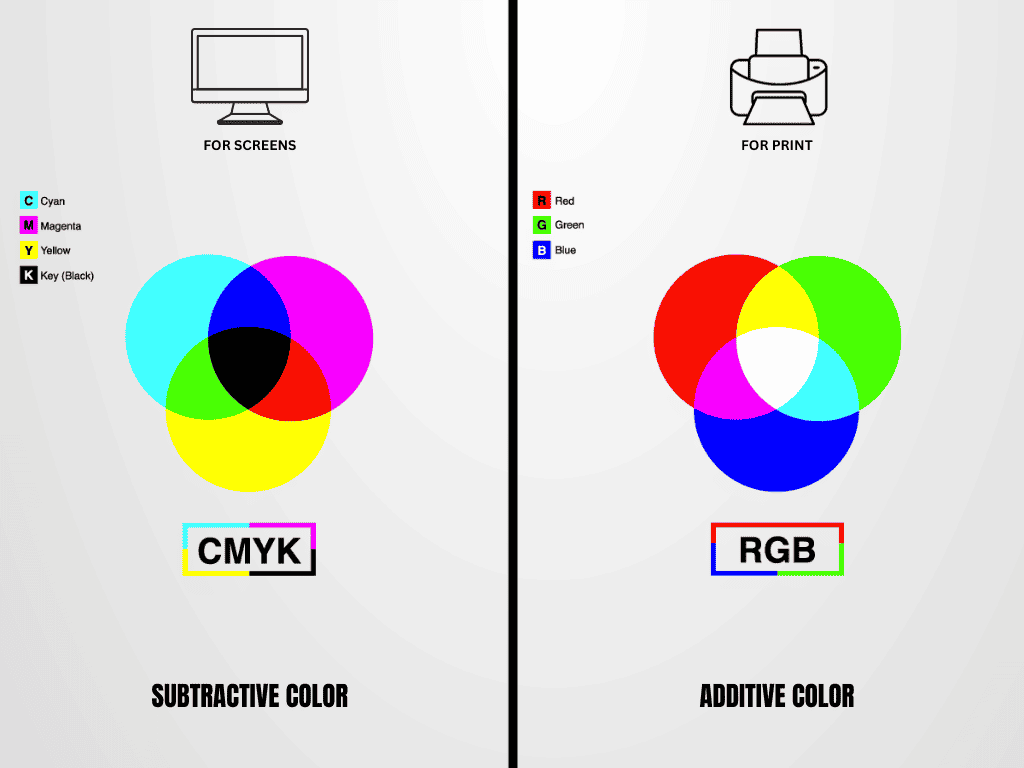
Colors that make red involve at least one shade of red in the mixture. However, there is a misconception that no combination of two colors can make red in subtractive mixing since red is a primary color.
You may be wondering what two colors make red. The short answer is magenta and yellow. When you mix magenta and yellow, the hues cancel out all other wavelengths of light except red.
Magenta is a purplish-red color produced by mixing equal parts of red and blue.
When magenta and yellow pigments are mixed, the resulting color is red due to the principles of subtractive color mixing. The magenta pigment absorbs green light and reflects the red and blue light. On the other side, yellow absorbs green light and reflects the red and green light.
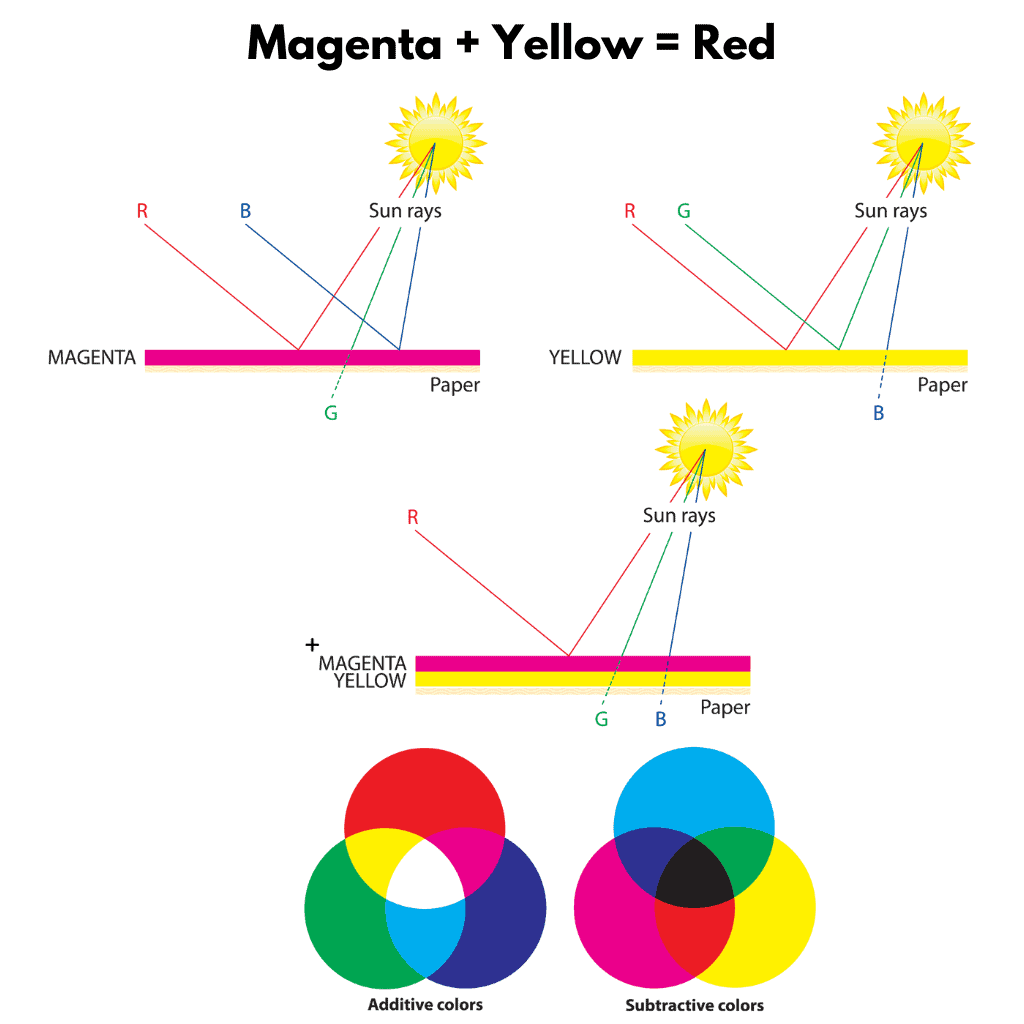
By mixing magenta and yellow, blue and green light are subtracted from the incident light, allowing only red light to be reflected. That’s because magenta reflects red and blue light, and yellow reflects red and green light.
Magenta pigment absorbs green light, allowing red and blue light to pass through. Yellow absorbs green light and allows the red and green light to pass through.
It’s all about the absorption and selective reflection of light.
You can see this by looking at the CMY color wheel. CMY is a subtractive color model used in color printing. The primary colors of this color space are cyan, magenta, and yellow.
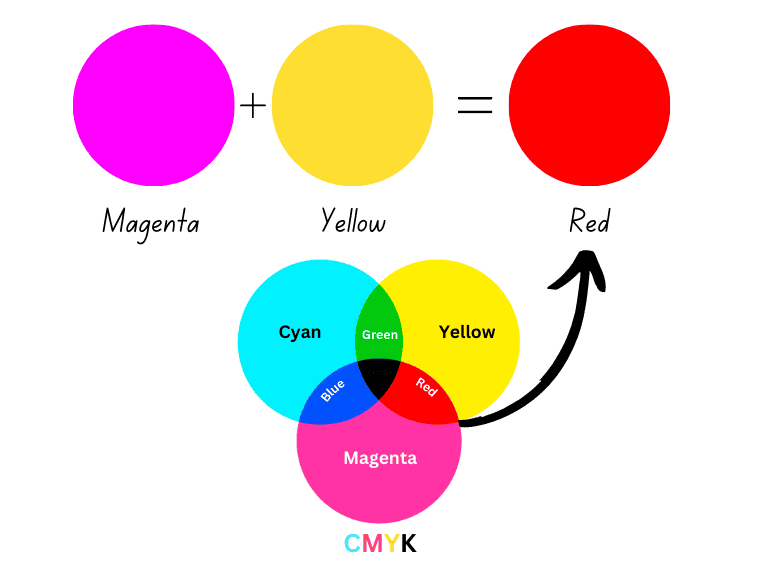
That doesn’t mean you can’t achieve different reds using other shades.
Mixing Different Shades of Red
In the world of color, there are over 500 different hues, shades, or tints of red.
Once you achieve red, you can create other shades of red. These include Mahogany, Crimson, Cherry Red, Raspberry, or Strawberry Red.
Let’s see how you can mix red with other colors to get different shades of red.
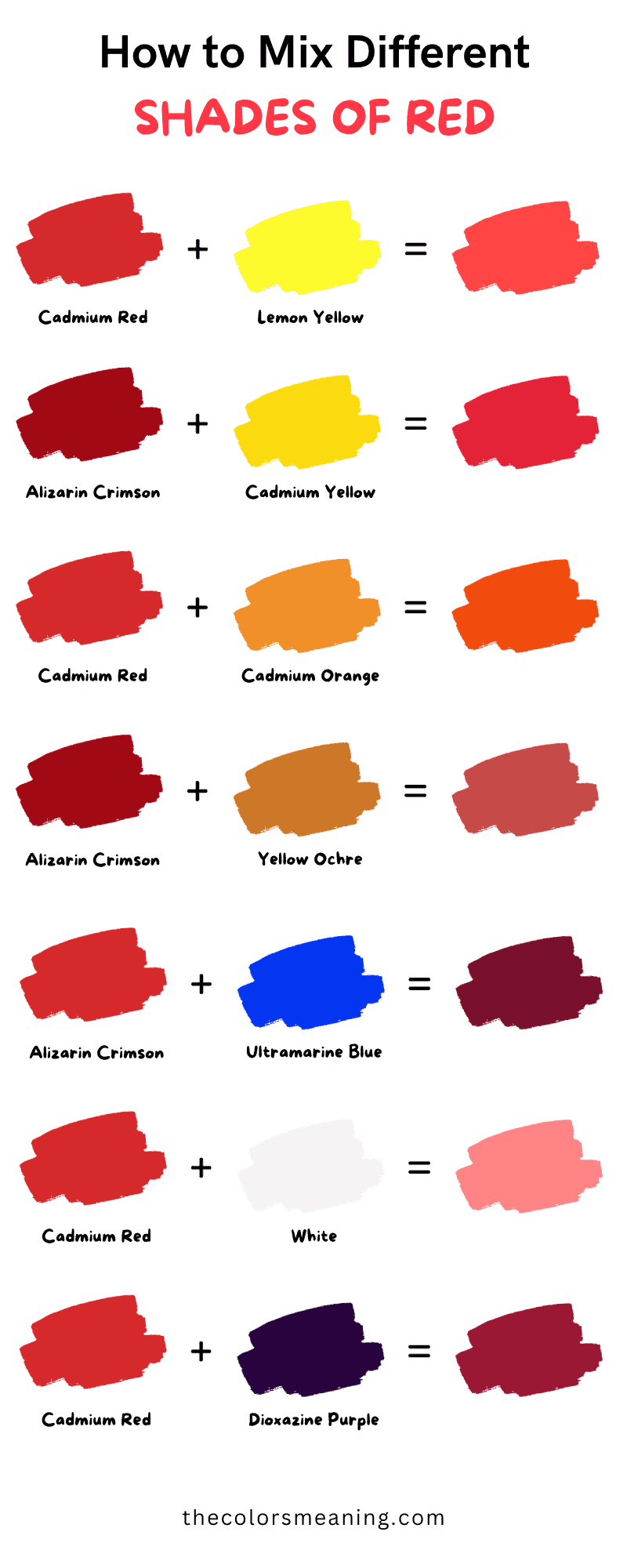
But that doesn’t mean you can’t use other colors to get red.
For example, green is the opposite of red or its complementary color. And when you mix two complementary colors, they cancel out each other’s hue, and you get a muddy brown.
Here’s how you can mix different shades of red:
Candy Apple Red = hint of orange + red
Raspberry Red = hint of magenta + red
Cherry Red = heavy black + light red
Crimson = hint of blue + red
Rose Red = hint of blue + white + red
Strawberry Red = hint of orange + white + red
Hibiscus = hint of violet + red
Indian Red = hint of white + blue + red
Mahogany = one part blue + two parts red
Ruby Red = hint of black + red
Mulberry Red = hint of Crimson + red + a touch of white
Maroon = hint of Crimson + blue
If you want to mix red-orange shades, you can mix Cadmium Red with Cadmium Orange or Cadmium Lemon.
If you prefer darker shades like maroon, mix Alizarin Crimson with Cadmium Lemon or Cadmium Orange.
These are just a few shades of red you can mix with paints. Technically, when you add white, you create tints of red. On the other hand, adding black produces tints of red.
Adding white lightens the tint of red while adding black darkens the shade.
If you want to change the value of the red without altering the hue, you should mix pure red with white or black. However, too much black can dramatically change your color.
For example, pink and raspberry are tints of red, while maroon and scarlet are shades.
To produce more shades of red, you can mix red and orange with some white or red and blue with white or black. The easiest way is to experiment on your own.
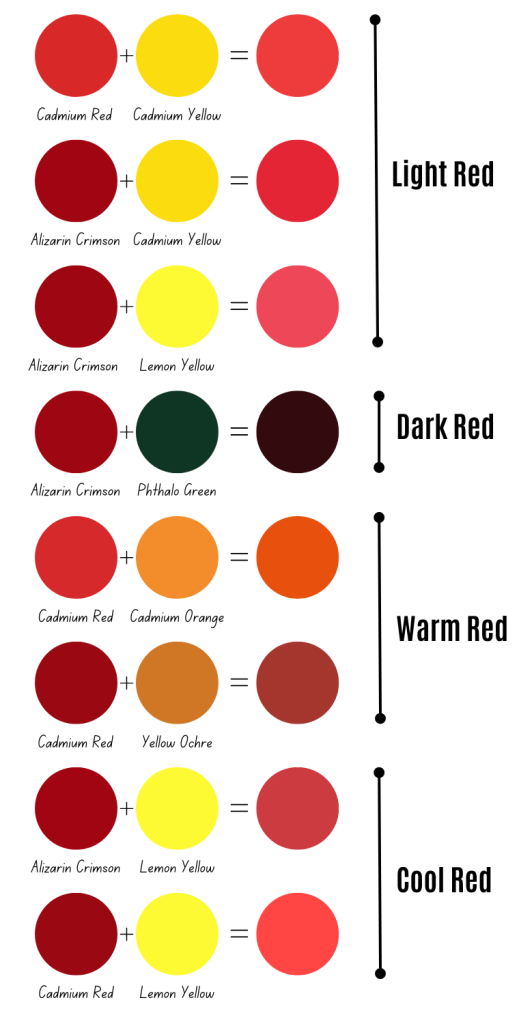
Dark red can be created by mixing cadmium red or alizarin crimson with phthalo green. Alternatively, you can combine alizarin crimson with ultramarine blue, then add burnt umber.
Need a light red? Mix cadmium red and cadmium yellow or alizarin crimson with lemon yellow.
If you want to make a muted red, mix cadmium red with hookers or phthalo green. If you want a darker tone, use alizarin crimson instead of cadmium red.
Want a warm red? You can produce it by mixing alizarin crimson and cadmium yellow. If you want a warm orange-red, mix cadmium red and cadmium orange.
If you want to make a cool red, you can mix cadmium red or alizarin crimson with ultramarine blue.
Moreover, if you want to make a muted red, you can mix cadmium red with cadmium green; alizarin crimson with cadmium green; or alizarin crimson with pthalo green; Don’t forget to add some white to your red base.
Furthermore, adding black and white can create different tints and shades. However, the best method is trial and error to get to the desired shade.
The Importance of Color Bias
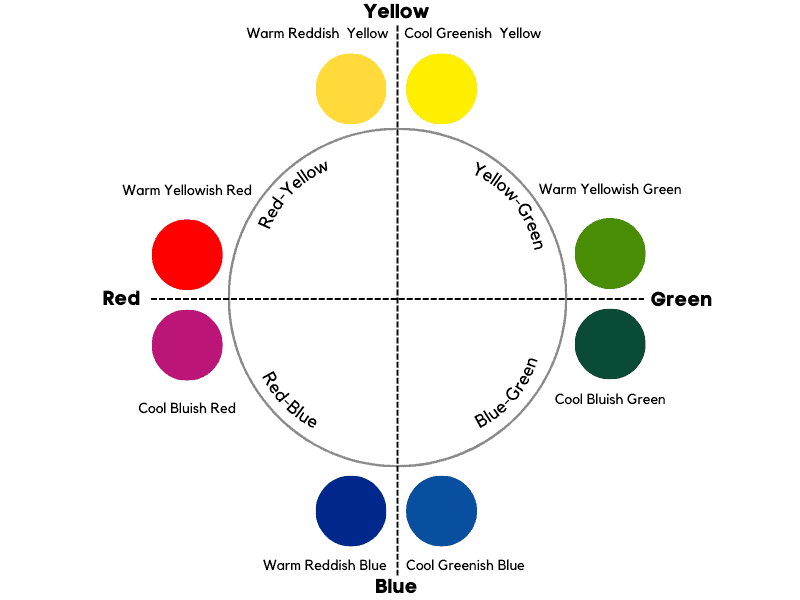
Every color carries a bias, meaning that it leans towards another color. So, the color temperature of the paints used in mixing red is critical.
For example, a red that leans towards yellow is not pure but a warm yellowish red. The same applies if it leans more toward blue, resulting in a cool bluish-red.
The same applies to yellow. It can be a warm reddish-yellow – leaning towards red or a cool greenish yellow – leaning more towards green.
Thus, the temperature of the mixed red depends mainly on the color bias. If you want to make a cool red closer to purple than orange, add a splash of blue. On the other hand, if you want a warm red, mix a warm yellowish red with a warm reddish yellow.
Did you like this article about the colors that make red? Share it with anyone you think might be interested.

